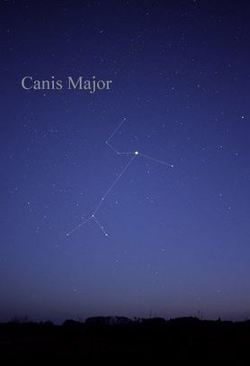 Canis Major featuring Sirius. Photo credit Wikipedia.
Canis Major featuring Sirius. Photo credit Wikipedia. This familiar phrase does a dog-gone good job of summing it up; hot days, warm nights, traveling, camping, music festivals, moving, hopefully some swimming and a siesta or two… and all the sweat, panting, and mint mojitos that go with it.
I came across the story behind this phrase and thought I would share it with you. Apparently it is an ancient saying that dates back to Roman times, originating from the observation that Sirius, known as the "Dog Star," rose at the same time as the sun during the month of August. In modern times in the northern hemisphere, we see this star rising very early in the morning and is best observed in the evenings of late winter and early spring in the southern sky. It’s called the Dog Star because it is the brightest star in the cancellation Canis Major, the Greater Dog. In fact, it is the brightest star in the sky, with a visual magnitude of -1.44 (the smaller the number the brighter the object). To put that in perspective, Sirius is often brighter than the planets Mercury and Mars! It appears so bright because it is one of the closest starts to us after our sun. But close is a relative term; it’s a whopping 8.6 light years away, nearly 6 trillion miles!
I love enjoying the warm nights of summer with a blanket, a loved one, and some star gazing. It reminds me of the vastness and mystery of the universe. Keep an eye out for satellites too! You'll know you're seeing a satellite if you find a very small point of light zooming across the sky, usually in the north-south or east-west direction. Their light source is an effect of sunlight reflecting off the shiny surfaces; that's why they don't blink like airplanes.
Ok, now back to nutrition. I hope you enjoyed this astronomical interlude. The physical science side of me has a tendency to ooze out into my writing every once in a while. I can’t help it; physics and astronomy play enormous roles in defining who I am and always will.
I came across the story behind this phrase and thought I would share it with you. Apparently it is an ancient saying that dates back to Roman times, originating from the observation that Sirius, known as the "Dog Star," rose at the same time as the sun during the month of August. In modern times in the northern hemisphere, we see this star rising very early in the morning and is best observed in the evenings of late winter and early spring in the southern sky. It’s called the Dog Star because it is the brightest star in the cancellation Canis Major, the Greater Dog. In fact, it is the brightest star in the sky, with a visual magnitude of -1.44 (the smaller the number the brighter the object). To put that in perspective, Sirius is often brighter than the planets Mercury and Mars! It appears so bright because it is one of the closest starts to us after our sun. But close is a relative term; it’s a whopping 8.6 light years away, nearly 6 trillion miles!
I love enjoying the warm nights of summer with a blanket, a loved one, and some star gazing. It reminds me of the vastness and mystery of the universe. Keep an eye out for satellites too! You'll know you're seeing a satellite if you find a very small point of light zooming across the sky, usually in the north-south or east-west direction. Their light source is an effect of sunlight reflecting off the shiny surfaces; that's why they don't blink like airplanes.
Ok, now back to nutrition. I hope you enjoyed this astronomical interlude. The physical science side of me has a tendency to ooze out into my writing every once in a while. I can’t help it; physics and astronomy play enormous roles in defining who I am and always will.
 RSS Feed
RSS Feed